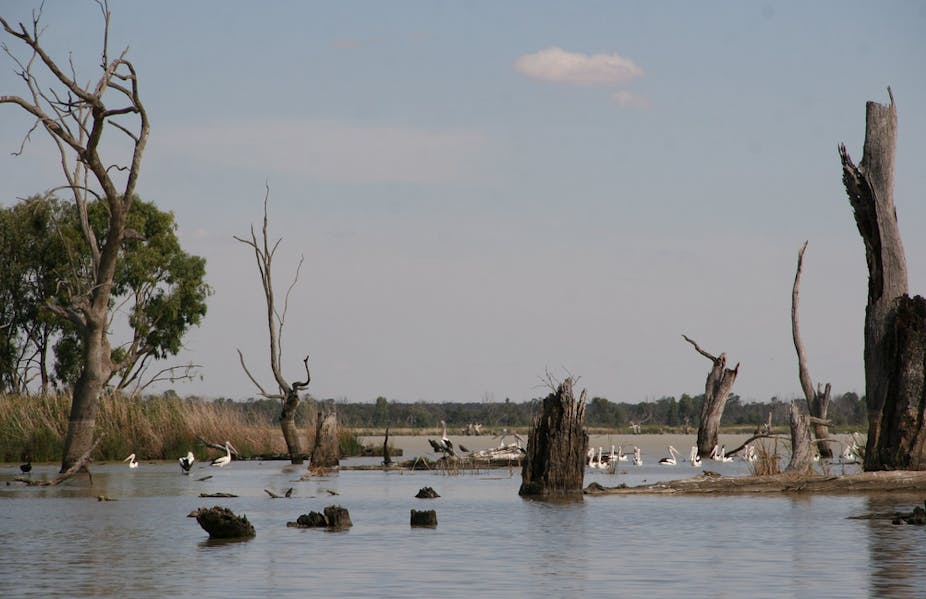The environmental health of Murray-Darling Basin has been an issue for several decades.
The Council of Australian Governments introduced significant reforms in the 1990s that are assisting in environmental restoration of the Basin. One of the most important was disentangling water ownership from land ownership. This has made water tradable between users and, in the southern Basin, tradable between catchment regions. It has also paved the way for the Commonwealth to enter the market, buying water for the environment.
The “buyback” scheme, intended to return up to 2750 GL of environmental water to the river system, is just one of the policy instruments used in the environmental restoration of the Murray-Darling. The lion’s share of the funding is proposed for infrastructure improvements. We’ll talk more about that later.
Water, as a tradable commodity, now has a price. The droughts and flooding rains which are inflicted upon us mean that this price is highly variable. As the main users of irrigation water, farmers are part of the solution in environmental management. The buyback process involves compensation at market prices. It makes sense that if farmers are fully compensated, buybacks should leave them no worse off. Already farmers have willingly sold around 1300GL to the Commonwealth, indicating that for them the financial returns from the buyback scheme are greater than the returns from irrigation.
They are selling irrigation water only, not land – and non-irrigated land can still be productive. For example, during the worst of the drought, dairy farmers in the Basin reduced water use by almost two thirds. As the price of water escalated, it was a helpful option for farmers to be able to sell temporary water and purchase fodder. Dairy output dropped by only one quarter.
Crop farmers in the Basin are also flexible. Again, the drought gives us evidence. With water trading at more than $500 per megalitre in 2008, rice production dried up and the Deniliquin rice mill closed. Water trading enabled rice farmers to earn a return by selling their water to fruit farmers who needed to maintain orchards. The loss of orchards and vineyards during the drought would have been greater without this option.
The extreme and prolonged drought, while bringing undeniable hardship and job losses to the Basin, also provided further evidence of flexibility in a lot of farming in the region. In some cases, buybacks provided an alternative to foreclosure. When the drought finally broke, rice production recovered and the Deniliquin rice mill reopened, confirming that drought, not buybacks, caused its closure.
Modelling at the Centre of Policy Studies (CoPS) indicates that job losses in the Basin attributed to fully implemented buybacks are relatively few. Indeed, the same model predicted that, in the Basin, the long-term economic impact of the 2006-2008 drought would be several times greater than the impact of buybacks, due to several years of lost investment.
The Water Act 2007 included funding for infrastructure upgrades of more than half a million dollars per irrigator. Infrastructure upgrades provide extra water to both farmers and the river system. The state governments of New South Wales and Victoria favour these ahead of buybacks. The Victorian Government has even suggested that the current buyback target of 2750 GL should be reduced.
What’s wrong with infrastructure upgrades? To an extent, they are helpful. During the recent drought, images of precious water evaporating from open channels evoked the struggle faced by farms in the Murray Darling Basin. Channelling the water from river to farm more efficiently has obvious attractions, and it is good for economic activity in the Basin.
But, like any investment, the cost needs to be weighed up against the returns. In years of average rainfall, excessive investment in improving the infrastructure is simply not worth it. Throw in a few droughts and the returns are greater, but they are still not enough to justify the cost to any private investor. Infrastructure upgrades cost around five times as much per litre of water as buybacks. But while the Commonwealth foots the bill, governments in the upstream states continue to favour infrastructure upgrades.
If we are investing Commonwealth funds in a region, what should they be spent on? Saving water and saving jobs are both admirable objectives, but could we be smarter about how we achieve them?
There appears to be broad acceptance in the community of the need to sink substantial funds into returning water to the Murray Darling river system. New modelling at CoPS shows that the funds required to create one new job in the Basin from infrastructure upgrades could be used to create three to four jobs if invested in essential services in the Basin instead. To understand why this is so, we examined census employment data for the Basin. Three quarters of all jobs in the Basin are in services; just 18 per cent are in farming, other primary industries or food processing.
Hospitals, schools, TAFEs and aged care facilities in the larger regional centres and small towns of the Basin may be hanging on by a thread. Regional policy should concentrate on maintaining funding where it is the most efficient provider of jobs. This is in services rather than infrastructure upgrades.

